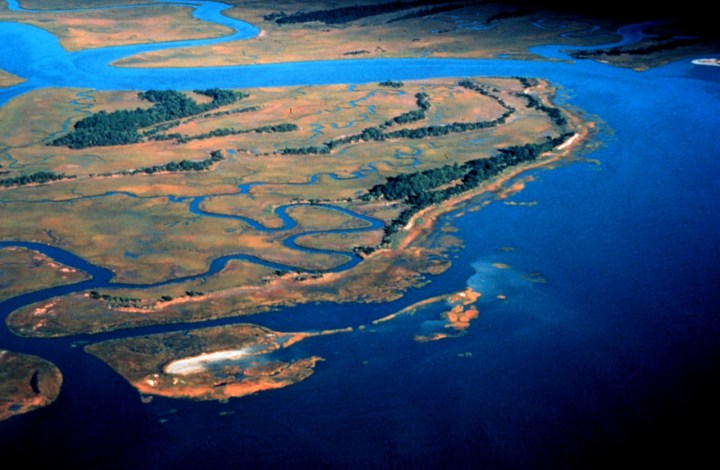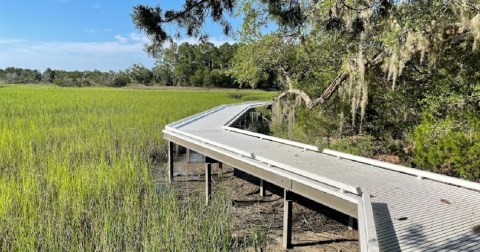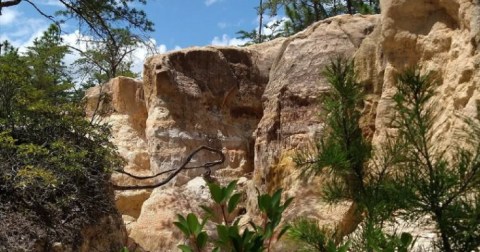15 Incredible Natural Wonders In South Carolina That Defy Explanation
Get ready for a ride through the Palmetto State with this list of incredible natural wonders in South Carolina. These American marvels, from the ancient Angel Oak to the mystical charm of Congaree National Park, are the stuff of bucket list dreams. Join me as we explore the unexplained and extraordinary side of South Carolina’s natural wonders, promising a journey that’s anything but ordinary!
Best Gorges & Canyons In South Carolina
Sure, South Carolina may not have the epic gorges of North Carolina, but let me tell you, the lake views here are no joke. Just look at those grand bodies of water! Jocassee Gorges is like a hidden paradise, with untouched forests, waterfalls, and wildlife vibes. Then there’s Table Rock State Park, where you’ve got this massive Table Rock mountain as your backdrop while you explore fun trails and soak in spectacular water views. So, maybe not gorges, but South Carolina’s nature game is strong – just as awesome if you ask me!
1. Jocassee Gorges

Jocassee Gorges is a natural wonderland located in one of the few remaining regions on earth with an unspoiled and pristine forest ecosystem. It was listed as the ninth spot in National Geographic's "50 of the World's Last Great Places" publication in 2012. It spans over 43,000 acres and has everything from untouched mountain forests to crystal clear streams, cascading waterfalls, unique wildlife, and over 60 rare and endangered plant species. Fun fact - you can spot more salamanders there than anywhere else in the world!
2. Table Rock State Park

Table Rock State Park is a 3,000-acre park with a towering mountain as its backdrop. Visitors can enjoy a variety of facilities, including cabins, a campground, and hiking trails that lead to the tops of Pinnacle and Table Rock mountains. The park is also steeped in history, with many structures built by the Civilian Conservation Corps still standing and listed on the National Register of Historic Places. The Table Rock Trail offers stunning views of the surrounding mountains and valleys and is a must-do activity for visitors.
Best Caves In South Carolina
Discover South Carolina’s hidden wonders as we explore exceptional caves and tunnels – the enigmatic Stumphouse Mountain Tunnel, a historic site echoing the unfinished Blue Ridge Railroad project, and the distinctive Aboveground Cave at Forty Acre Rock Heritage Preserve. These sites promise a captivating journey into the must-see caves of the Palmetto State.
3. Stumphouse Mountain Tunnel

So there's this spot in Oconee County, South Carolina, called Stumphouse Mountain Tunnel. Back in the 1850s, they tried building the Blue Ridge Railroad to link Charleston to the Midwest, but thanks to the Civil War and some tough times, it never got finished. Now, it's part of Stumphouse Park and even made it to the National Register of Historic Places in 1971. You can take a family-friendly stroll into the tunnel - it's about a quarter-mile and stays a chill 50 degrees inside. Don't forget your flashlight!
4. Forty Acre Rock Heritage Preserve's Aboveground Cave

Check out Forty Acre Rock Heritage Preserve in South Carolina for a day of hiking. The rock pools up there are a burst of colors, and you even get to see a decent-sized aboveground cave – pretty cool for the Palmetto State. Two trailheads are up for grabs: a short one from the upper parking deck and a longer, more adventurous one from the lower deck. If you go for the lower trail, you'll find Campbridge Waterfall, and keep an eye out to the far right for the aboveground cave.
Best Waterfalls In South Carolina
Natural attractions in South Carolina are abundant, but few are as mesmerizing as the state’s beautiful waterfalls. Among the most impressive are Brasstown Falls, Issaqueena Falls, and Laurel Fork Falls, offering something for everyone, from adventurous hikers to leisurely picnickers. Escape into nature and discover some of South Carolina’s most awe-inspiring waterfalls.
5. Brasstown Falls

Guess what's tucked away on the southern edge of Sumter National Forest? Brasstown Falls – a 120-foot beauty, showing off in three awesome drops. Oh, and there's more! Little Brasstown Falls is right there too, just a hop away from the same parking spot. The whole adventure to see both waterfalls is roughly a mile round trip.
6. Issaqueena Falls

Issaqueena Falls stands out as a must-visit spot in Oconee County, conveniently located within Stumphouse Park. Surrounded by myths and mysteries, these falls hold a captivating charm. You can check it out without a long trek - it's just a quick stroll, less than a third of a mile. The falls are no joke, dropping over 200 feet, and there's a sweet pavilion for a killer view. Feeling more adventurous? Take the steep trail down to the base for the full waterfall experience. Issaqueena Falls is all about breathtaking beauty, and it's totally worth a visit.
7. Laurel Fork Falls

Laurel Falls, tucked in Pond Mountain Wilderness, is a hiker's dream with its massive 40-foot height and 50-foot width, set in a gorgeous landscape. Getting there can be a challenge, so pack good shoes and be ready to break a sweat. Choose between the adventurous 5.5-mile Hampton Blueline/Laurel Falls Trail with a bit of Appalachian Trail action or take the more laid-back 2.6-mile route from Dennis Cove along the Appalachian Trail. Feeling a bit leisurely? Skip the long hike and hop on a boat ride in Lake Jocassee instead. It's a win-win!
Best Overlooks & Scenic Vistas In South Carolina
Embark on a visual odyssey through South Carolina’s best overlooks, starting with Caesar’s Head Overlook for panoramic views from the Blue Ridge Escarpment (the point where the Blue Ridge Mountain Range descends toward the foothills of Upstate South Carolina). Our adventure continues to the hidden gem, Jumping Off Rock Overlook, offering thrilling cliffs and unparalleled vistas of Lake Jocassee and surrounding mountains.
8. Caesar's Head Overlook

Caesars Head and Jones Gap State Park connect within the 17,000-acre Mountain Bridge Wilderness Area, featuring pristine southern mountain forests. Hikers can explore various loops, like the standout Overlook Trail that offers stunning vistas of the remarkable Blue Ridge Escarpment.
9. Jumping Off Rock Overlook

Jumping Off Rock is the hidden gem for the ultimate view of Jocassee Gorges. Tucked in the 33,000-acre Jim Timmerman Natural Resources Area, reaching this spot is a bumpy, twisty joyride on Horse Pasture Road. Along the way, catch glimpses of small waterfalls and overlooks. About eight miles in, there's the North Carolina Overlook, a perfect pit stop with a view. Finally, Jumping Off Rock treats you to a spectacular sight - just nature at its best, with trees, mountains, and Lake Jocassee.
Best Rock Formations in South Carolina
Discover South Carolina’s captivating rock formations at Hanging Rock Battleground and Bald Rock Heritage Preserve. From historical significance to panoramic views, these sites offer a unique glimpse into the state’s geological wonders.
10. Hanging Rock Battleground

Hanging Rock Battleground Park, taken care of by the South Carolina Department of Parks, Recreation, and Tourism, is just two miles south of Heath Springs. It sits on a piece of the 1780 battlefield, marked by a stone and boulder trail off Hanging Rock Road that tells the battle story. Head a bit north on Flat Rock Road, close to Hanging Rock Creek, to see where the British camps got hit.
11. Bald Rock Heritage Preserve

Heading to Caesars Head State Park? Keep an eye out for parked cars on the east side of U.S. 276, about five miles from the park. That's the spot for Bald Rock, a scenic overlook with epic mountain views. Cross a wooden footbridge, and you'll hit a massive rock area - big enough for a football field. This Bald Rock spot is part of the Bald Rock Heritage Preserve, giving views of Pickens and Greenville county foothills and the famous Table Rock granite dome. Find your spot on the rock, kick back, and feel on top of the world.
Unique Natural Wonders in South Carolina
Explore South Carolina’s unique natural wonders in the heart of the Lowcountry – Boneyard Beach’s captivating seashell-strewn shores, the expansive wetlands of ACE Basin, the ancient grandeur of Angel Oak, and the rich biodiversity of Congaree National Park. This must-see nature in South Carolina epitomizes the state’s diverse landscapes, making the state an essential gem in North America’s natural crown.
12. Boneyard Beach

Encompassing 4,900 acres, Bulls Island stands as the largest among the barrier islands within the refuge. Once home to the deactivated Bulls Bay Light, lost to the sea in 1913, the island boasts Boneyard Beach. This unique coastal stretch bears witness to the sea's encroachment on a forest, leaving behind the remains of a water-stranded forest and an abundance of driftwood, creating a captivating shoreline landscape.
13. ACE Basin

ACE Basin is one of the Seven Wonders of South Carolina, tagging along with iconic locations like Sassafras Mountain, Jocassee Gorges, Chattooga River, Congaree National Park, Edisto River, and Bulls Island. Nestled around the Ashepoo, Combahee, and Edisto rivers, it's a massive 1.6 million-acre playground of undeveloped wetlands and uplands. Picture a diverse mix of forests, tidal marshes, barrier islands, and peatlands – it's like nature's own theme park. With 33 natural plant communities, ACE Basin is a hotspot for waterfowl, migratory birds, and endangered species. This place is the real deal when it comes to South Carolina's natural wonders.
14. Angel Oak

The Angel Oak Tree on John's Island, near Charleston, South Carolina, is a living legend estimated to be 400 to 500 years old. Standing tall at 66.5 feet with a massive 28-foot circumference, this giant provides shade across 17,200 square feet. It's a must-see in Charleston, Kiawah, or Seabrook Islands, and if you're driving by, you can't miss it. Owned by the City of Charleston, the park is free, so swing by and soak in the history of one of the oldest living things in the country.
15. Congaree National Park

You wouldn't believe the amount of different plants and animals that call Congaree National Park home! It's the biggest expanse of old-growth bottomland hardwood forest left in the southeast of the United States, and it owes a lot of its success to the Congaree and Wateree Rivers. These rivers bring in all sorts of good stuff that keeps the ecosystem healthy and growing, including plenty of champion trees that are the pride of the park.
And just like that – the incredible natural wonders of South Carolina! Have you checked out any of these spots? Which are your faves? If you’re looking for more natural wonders, check out Carolina bays. Or maybe you want more waterfall action? You can’t miss Lower Whitewater Falls.
If you’re planning to hit the road to check out some of these nature places in South Carolina, be sure to write a handy packing list!
OnlyInYourState may earn compensation through affiliate links in this article. As an Amazon Associate, we earn from qualifying purchases.




